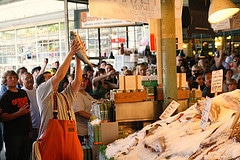A Better Product?
I’ve worked in customer support and sales with wildly different products over the years. Adobe software. Fine art. Curly wigs and tiaras for Irish dancers. But I think the experience that taught me the most was selling goat cheese at Pike Place Market in Seattle.
Selling goat cheese to tourists wasn’t an easy proposition. Not at first. Very few people get excited about goat cheese. When people hear the word “goat,” they think of a homely, bearded face. And if they’ve ever actually met a goat, they think of its pungent, goaty smell. After a few days of watching people cringe whenever I offered them a sample of our finest goat cheese, I figured I probably needed to look for a more lucrative product to sell.
But when I looked around, I noticed something striking. The successful vendors at the market didn’t have a better product. They had a better story. A better vision. They knew how to connect with the customers. How else could they sell thousands of dollars worth of whole fish, fresh vegetables and floral bouquets – to tourists staying in hotel rooms without refrigeration, cooking facilities or a vase?
Listening is Key
The successful vendors listened to their customers. Really listened. They went beyond, “Are you interested in buying a fish?” They knew how to strike up a conversation: “Where are you from? Are you visiting family in Seattle? What have you got planned while you’re in town?” And they kept the conversation going by listening.
It was listening to customers at the market that revealed a secret: most people weren’t shopping for any particular item. They were shopping for fun, for photo opps, for a memorable time with family. The vendors who listened, figured it out. And then they could tell a compelling story.
Telling a Story, Sharing a Vision
The story began with the shopping experience itself – because that is what the customers said they wanted! They wanted The Pike Place Market Experience. So the successful vendors sold an experience. They arranged their veggies like a colorful tapestry. They cheerfully posed for photos as they created floral bouquets. And they tossed whole fish back and forth through the air (quite famously now) when they made a sale.
The stories these vendors told also included a vision that showed how their flowers (or fruit or fish) would enhance the vacation experience of their customers. “Why not bring tulips to Grandma when you visit this evening… Snack on bing cherries as you explore the city today (and spit the pits at your brother!)… Send a whole salmon home to your neighbor as a thank you for walking your dog.”
Eureka!
I could provide The Pike Place Market Experience! I brought in checkered table cloths, pictures of the farm and a big sign that said “Carpe Diem!” (Seize the Day! It was a conversation starter…) And once I started listening, I could tell stories that included goat cheese. “You’re here to explore a big city? Goat cheese is sophisticated! You’re here to do some hiking? Goat cheese is good for you! You’re here on your honeymoon? Goat cheese makes a romantic picnic!”
Don’t sell the goat. Sell the picnic. I learned my lesson, and I started selling loads of goat cheese!
How does all this relate to countertops?
I knew a lot about goat cheese. You know a lot about stone. And the fabrication process. And the right way to polish quartz. And what sealant is best for granite. It is really tempting to try to impress your customer with product knowledge, but most customers really don’t care about saws and sealants and adhesives. At least not at the start of the conversation. They have something else on their minds. Creating a safe home for their children? Hosting fabulous parties? Making a good investment? You won’t know unless you listen. And once you listen, then you can tell a story that will help the customer visualize the solution that you can provide.
In a recent Stone Industry Education event in Dallas, GK Naquin spoke to fabricators about the same issue: you have to deliver to customer expectations. As GK explained, it doesn’t mean you have to read minds. You have to listen. Salespeople who listen will understand and even help shape customer expectations. They’ll know just what kind of picnic to pack!



